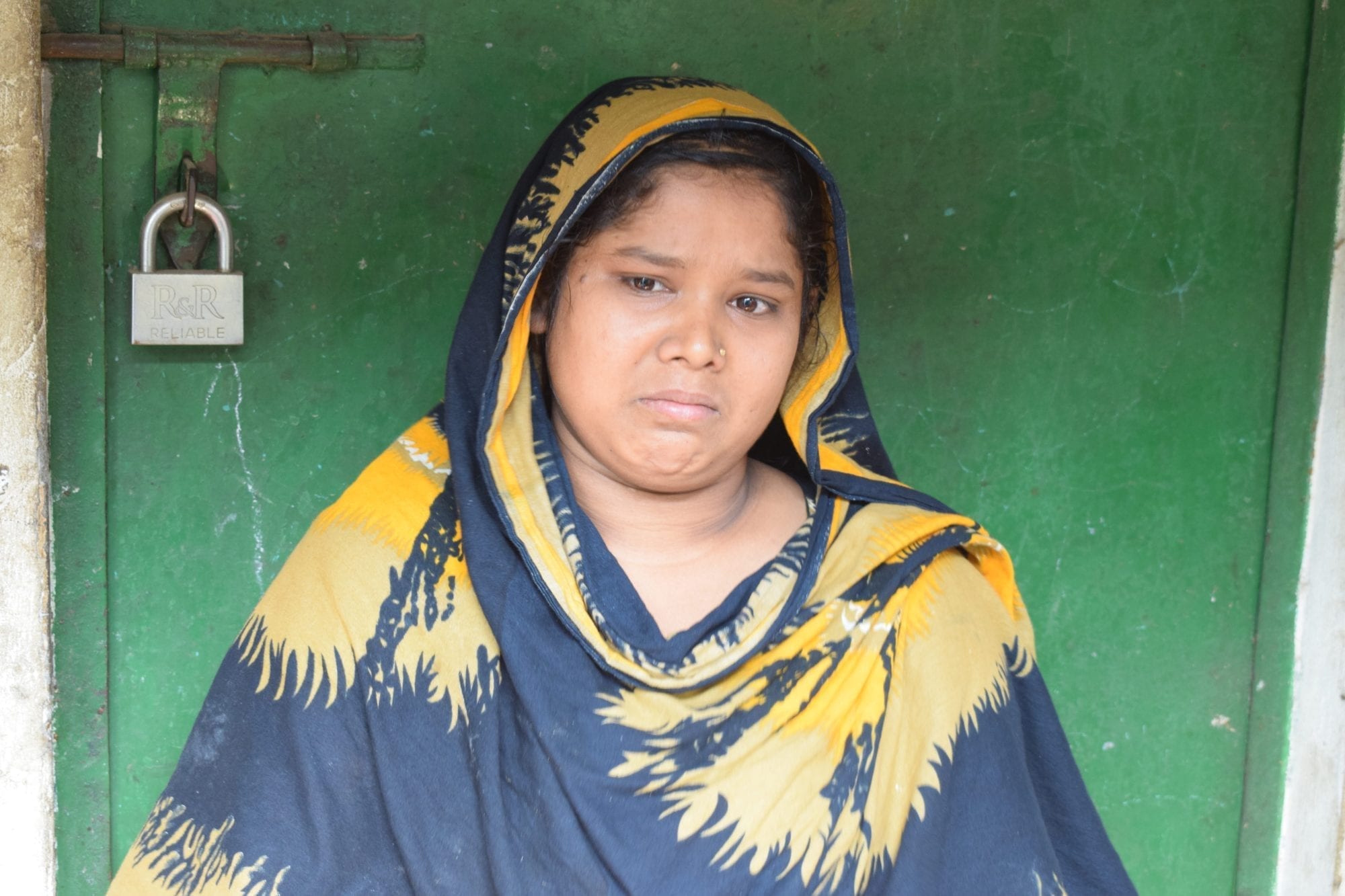
Apr 15, 2018
Following the Rana Plaza collapse in which 1,134 garment workers were killed and thousands more injured in Bangladesh, the horror of the incident spurred international action and resulted in significant safety improvements in many of the country’s 3,000 garment factories.
But five years after the April 24, 2013, disaster, Bangladesh garment worker-organizers say employers often are not following through to ensure worksites remain safe, and the government is doing little to ensure garment workers have the freedom to form unions to achieve safe working conditions. Since the Tazreen Factory fire that killed 112 garment workers in 2012, some 1,303 garment workers have been killed and 3,875 injured in fire-related incidents, according to Solidarity Center data.
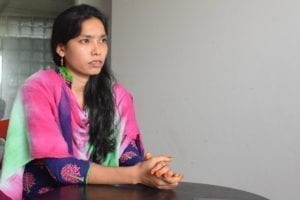
“Five years after the tragedy, the police and local leaders are supporting the factory owners and harassing us”—Tomiza, worker-organizer. Credit: Solidarity Center/Mugfiq Tajwar
“Pressure from the buyers and international organizations forced many changes, says Tomiza Sultana, a garment worker-organizer with the Bangladesh Independent Garment Workers Union Federation (BIGUF), among them less interference by police and factory management. “ We organized trade unions, recorded complaints and trained many workers.
“But five years after the tragedy, the police and local leaders are supporting the factory owners and harassing us and anyone who wishes to come to us. They have forgotten the lessons of the disaster,” she says.
A Disaster that ‘Cannot Be Described in Words’
“I can vividly recall that day. I can still see the faces of families who were looking for the bodies of their loved ones by only holding their photo ID,” says Nomita Nath, BIGUF president. “This disaster cannot be described in words.” The multistory Rana Plaza building, which housed five garment factories outside Dhaka, pancaked from structural defects that had been identified the day before, prompting building engineers to urge the building be closed. Garment workers who survived the collapse say factory managers threatened their jobs if they did not return to work.
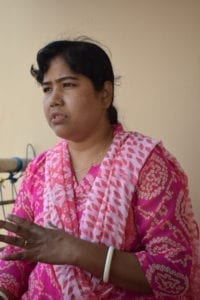
Factory owners did not care about our lives. They only cared about meeting production targets—BIGUF President Nomita Nath. Credit: Solidarity Center/Mugfiq Tajwar
Ziasmin Sultana, a garment worker who survived the collapse, recalls managers telling workers on the morning of April 24 the building was safe even though “the previous day, we had seen cracks [in the building] form right in front of our eyes.” Shortly after starting work, the electricity went out and the building began to violently shake.
After packing into a crowded stairwell to escape, Ziasmin says she found herself falling. “Everything happened in an instant and it was dark everywhere. When I came to my senses, I realized that three of us have survived and everyone else around us was dead.”
“The world saw how much our lives meant to the owners of these factories,” says Nomita. “They did not care about our lives. They only cared about meeting production targets.”
In the wake of Rana Plaza, which occurred months after a deadly factory fire at Tazreen Fashions killed 112 mostly female garment workers, global outrage spurred several international efforts to prevent deaths and injuries due to fire or structural failures. Safety measures were instituted at more than 1,600 factories.
Hundreds of brands and companies signed the five-year, binding Bangladesh Accord on Building and Fire Safety which mandated that brands and the companies they source from fix building and fire hazards and include workers in the process. Many of the signatories recently have signed on to the renewed three-year agreement that takes effect in May. Extending the Accord guarantees that hundreds of additional factories will be inspected and renovated.
Workers Still Struggle to Achieve Safe Workplaces
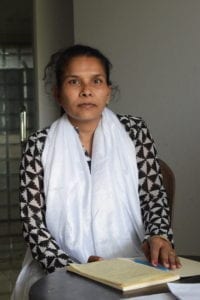
Maintaining the safety gains made after Rana Plaza is “a big task,” says Khadiza Akhter. Credit: Solidarity Center/Mugfiq Tajwar
In a recent series of Solidarity Center interviews, garment worker-organizers from several national unions applaud the significant safety improvements but warn that employers are backsliding. And workers seeking to improve safety in their factories often face employer intimidation, threats, physical violence, loss of jobs and government-imposed barriers to union registration.
“The Accord contributed to ensuring the safety of the factories, but there is a lot of other work that needs to be done,” says Khadiza Akhter, vice president of the Sommilito Garments Sramik Federation (SGSF). She and others interviewed say factories are not regularly inspected, employers do not ensure fire extinguishers and other safety equipment are properly maintained, and safety committees sometimes only exist on paper.
“We are now working in this area for maintaining the standard of fire safety. This is a big task in coming future,” Khadiza says.
The Solidarity Center, which over the past two decades in Bangladesh jump-started the process to end child labor in garment factories and served as a catalyst in the resurgence of workers forming unions, in recent years has trained more than 6,000 union leaders and workers in fire safety. Factory-floor–level workers learn to monitor for hazardous working conditions and are empowered to demand that safety violations be corrected. Many workers, in turn, share their knowledge with their co-workers.
Bangladesh at a Crossroads
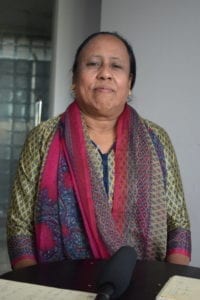
Garment workers can barely survive with such low wages—Momotaz Begum, worker-organizer. Solidarity Center/Mugfiq Tajwar
Accounting for 81 percent of the country’s total export earnings, Bangladesh’s ready-made garment industry is the country’s biggest export earner. Yet wages are the lowest among major garment-manufacturing nations, while the cost of living in Dhaka is equivalent to that of Luxembourg and Montreal.
“The workers can barely survive with such low wages, as their house rents and even food prices have risen,” says Momotaz Begum, who has worked as a garment worker organizer with the Awaj Foundation since 2008.
Without a union, garment workers often are harassed or fired when they ask their employer to fix workplace hazards or seek living wages. Worker advocates say Bangladesh is at a crossroads—and they hope the government and employers choose a future in which Bangladesh workers are partners in the country’s economic success and treated with the dignity and respect they deserve.
But even in the face of severe employer harassment and government indifference, worker-organizers like Khadiza, Momotaz, Tomiza and Nomita, all of whom began working in garment factories as children or young teens, are helping workers join together and insist on their rights at work. Today, 445 factories with more than 216,000 workers have unions to represent their interests and protect their rights.
“I believe that the workers must be aware of their rights and they must be united to achieve them,” says Shamima Akhter, an organizer with the Bangladesh Garment and Industrial Workers’ Federation (BGIWF). “We train them to let them know what they deserve, and we empower them so that they can claim their rights from the factory owners.”
In Bangladesh, the Solidarity Center implements the Workers Empowerment Program – Components 1 and 2, which provides training and rights education to garment workers and organizers, with the support of USAID.
Iztiak, an intern in the Solidarity Center Bangladesh office, conducted the interviews in Dhaka.
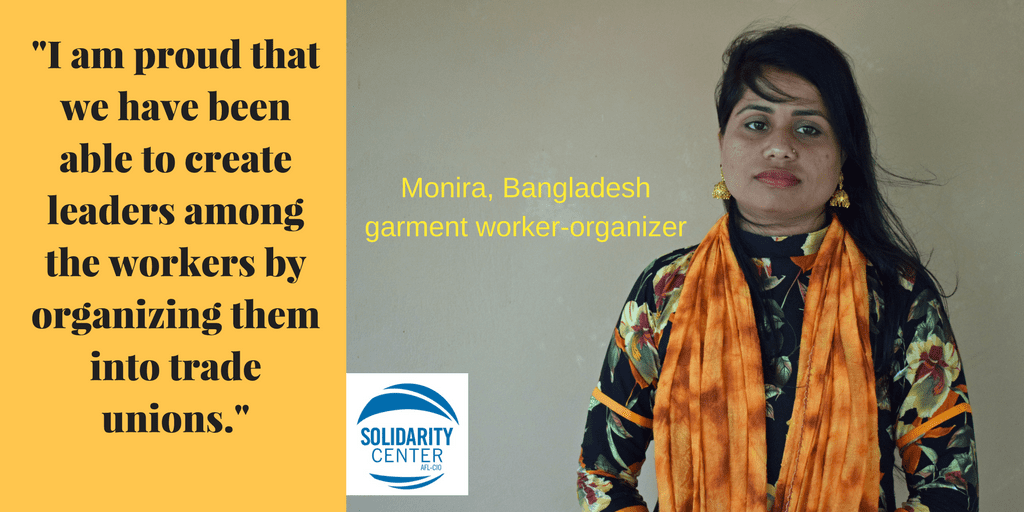
Apr 9, 2018
Five years after the deadly Rana Plaza building collapse in Bangladesh, workers and union activists say despite the massive demand from workers for union representation to achieve safe workplaces, worker-organizers must face down threats, harassment and violence to educate workers about their rights on the job.
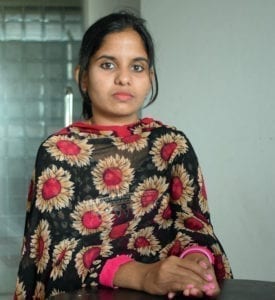
Shamima Aktar is among Bangladesh garment worker-organizers empowering workers. Credit: Solidarity Center/Mugfiq Tajwar
Since the April 24, 2013, tragedy in which more than 1,130 garment workers died and thousands were injured, the government has approved a little more than half of the garment unions that have applied for official registration, according to Solidarity Center data. Confronted with employers and a government hostile to worker organizations, worker-organizers have sometimes risked their lives to help workers improve wages and working conditions.
Shamima Aktar, a garment factory worker and organizer with Bangladesh Garment and Industrial Workers’ Federation (BGIWF), is one of them. During a meeting with management at a newly unionized factory, managers refused to grant a demand made by the factory union that salaries be paid on a timely basis. Instead, Shamima and the other union representatives were locked in the building and beaten, she says.
“But what moved me was that hearing about our abuse, 17 trade unions around the community immediately came to our aid and barricaded the whole factory which we were in. The workers needed us on their side to be able to live in peace and I wish to [keep organizing] no matter how difficult it is for me,” she says.
Through persistence and courage in the face of daunting odds, worker-organizers have helped garment workers form unions despite the severe obstacles. In Bangladesh, more than 200,000 garment workers at 445 factories are represented by unions that protect their rights on the job.
“I have worked day and night, went to gates of factories to talk to the workers, walked with them to their homes to earn their trust and to make them aware of how they are being exploited and deprived of their rights,” says Monira Aktar, an organizer with the Bangladesh Independent Garment Workers Union Federation (BIGUF). “So far, we have united 2,250 workers into trade unions, and they say that we give them courage and hope. For me, these words are enough to encourage me to work on for them.”
Poverty Wages, Safety Improvements
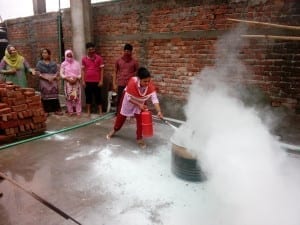
Thousands of garment workers have participated in the Solidarity Center’s 10-week fire safety certification course. Credit: Solidarity Center/Rakibul Hasan
Wages in Bangladesh are the lowest among major garment-manufacturing nations, even though the cost of living in Dhaka is equivalent to that of Luxembourg and Montreal. The country’s labor law falls far short of international standards, and the Bangladesh government has failed to enact meaningful legal reforms, including addressing the arbitrary union registration process that is vulnerable to employer manipulation. Without a union, garment workers often are harassed or fired when they ask their employer to fix workplace safety and health conditions.
But due to international action after the Rana Plaza disaster, which occurred months after a deadly fire at Tazreen Fashions Ltd. factory killed 112 mostly female garment workers, a variety of efforts to prevent unnecessary deaths and injuries due to fire or structural failures—including the Bangladesh Accord on Building and Fire Safety—have remedied dangers at more than 1,600 factories.
The Solidarity Center has trained more than 6,000 union leaders and workers in fire safety, helping to empower factory-floor–level workers to monitor for hazardous working conditions and demand safety violations be corrected.
Such international attention has opened up space for workers to collectively demand—and win—improvements on the job, says Monira.
“I am proud that we have been able to create leaders among the workers by organizing them into trade unions. In the past this would have been close to impossible.”
In Bangladesh, the Solidarity Center implements the Workers’ Empowerment Program – Components 1 and 2, which provides training and rights education to garment workers and organizers, with the support of USAID.
Iztiak, an intern in the Solidarity Center Bangladesh office, interviewed the worker-organizers in Dhaka.
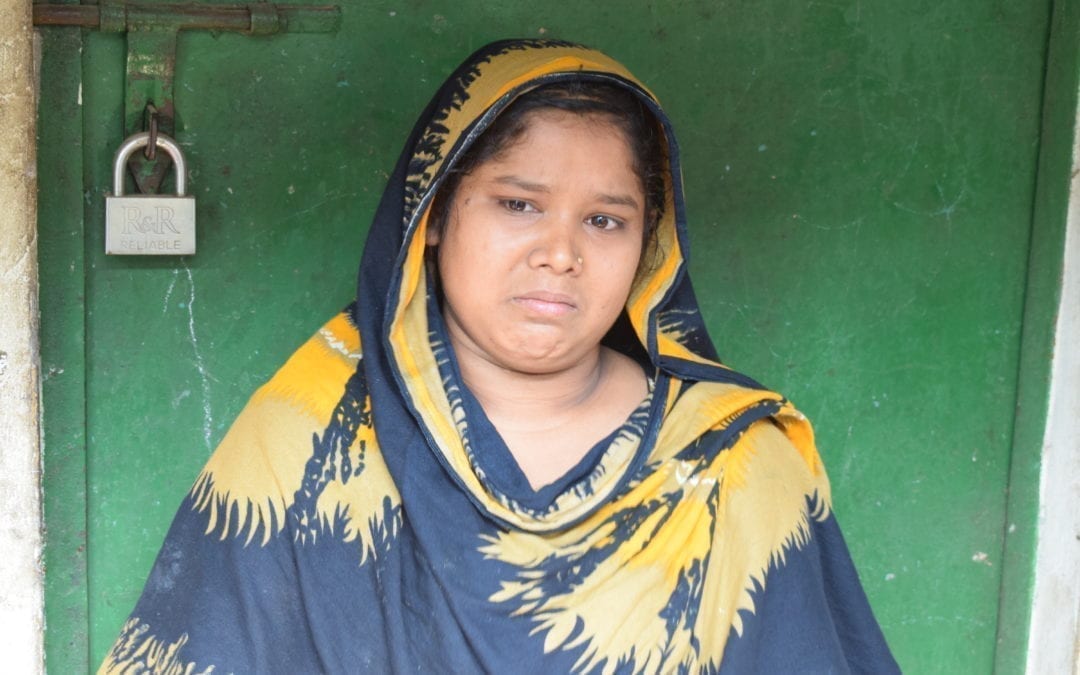
Apr 6, 2018
I am Ziasmin Sultana. I came to Dhaka at a very young age with my family and got married two years later in 2007. I was happy with my family even though our earnings were not much. It was in 2011 that I joined a factory in Rana Plaza hoping to provide for our growing family. I worked there for two years before the collapse.
There were about 1,000 workers on the second floor where I worked. There were no ceiling fans. The only ventilation we had was from the windows which was not enough, making it a very hot environment. I had to work overtime frequently as the basic salary was not much; going there at 8 a.m. and coming back at midnight. Moreover, we were frequently humiliated both verbally and physically. If the operators were caught talking to each other, they were made to stand on a stool at the front of the line holding their ears. This was our life.
This all changed on April 24, 2013. The previous day, we had seen cracks [in the building] form right in front of our eyes. We did not want to enter the building the next day but they announced that it was safe to enter, they had it checked with an engineer. So we reluctantly went in. At about 8:45 a.m., the electricity went out and the generator was turned on. Instantly, the building was shaking violently and we ran for our lives, fearing that danger was imminent.
Entering the stairway was nearly impossible as it became overcrowded. Just then, there was black smoke and suddenly, I found myself falling. Everything happened in an instant and it was dark everywhere. When I came to my senses, I realized that three of us have survived and everyone else around us was dead. I thought this is where my grave would be, as there was no way to escape.
After many hours, we could see a glimpse of light and we crawled towards it over the lifeless bodies of our colleagues. The rescuers found us and they came down with ropes. I did not have the strength to hold on to it, but I realized that this was not the end of me after all. They took me to a hospital to be treated and I was physically well after a few days.
Even after five years, I can still hear the cries of my colleagues who were crushed under the concrete. Sometimes I cannot sleep—I am gripped with fear that the ceiling is falling over me and I run to another room in the middle of the night. It is difficult for me to work, as I frequently become ill and tired.
Still, our lives move on. It is true that the salary has increased but the managers’ behavior has not improved. We have to keep working with our mouths sealed. But after what I have been through, I realize how lucky I have been and I hope that things will improve for my children in the future.
As told to Istiak, an intern in the Solidarity Center Bangladesh office.
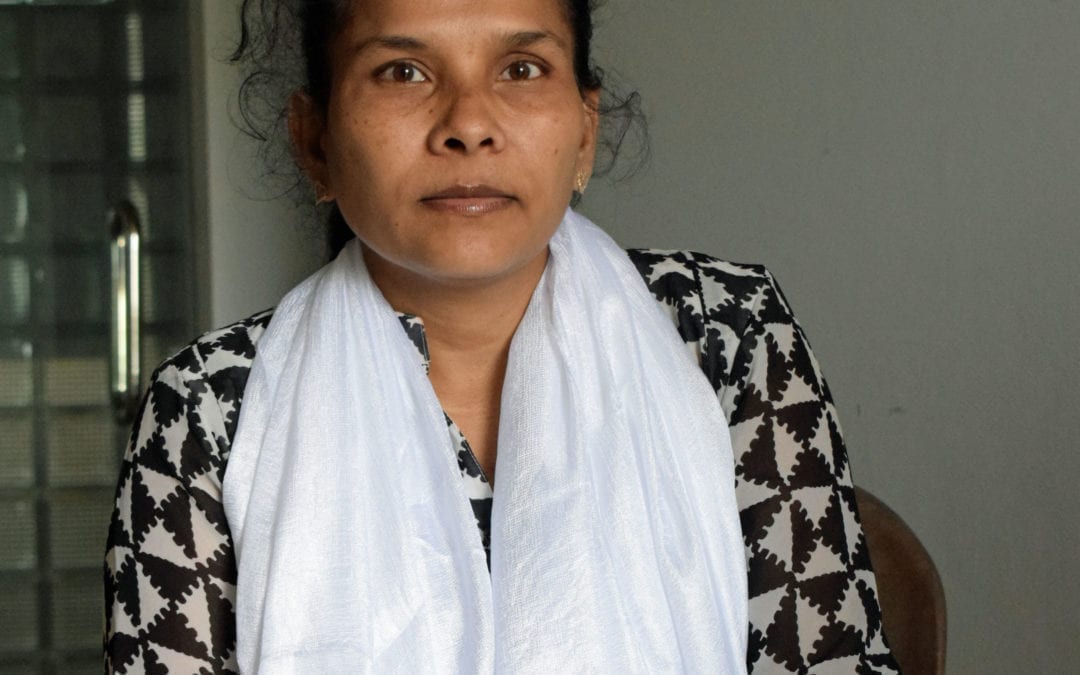
Apr 5, 2018
I am Khadiza Akhter, vice president of the Sommilito Garments Sramik Federation (SGSF), where I have worked since 2008.
I started to work in a garment factory at a very young age. My family was poor, so I did not have the luxury to continue my education. One day I came to know about a federation (BIGUF) which was led by women. As women leaders were rare I went to attend one of the sessions of that federation. There, for the first time, I heard about labor law.
Factories did not follow Bangladeshi labor law. When I tried to raise voice against malpractices, my supervisors threatened my job. Our factory did not have an active union so I could not take any legal action against such abuse, but I received training in labor law from my federation. Eventually I was blacklisted in the garment sector for my union work, but BIGUF offered me a job and I worked there for six years as an organizer.
In 2008, I joined Sommilito Garments Sramik Federation (SGSF). And I did try to unite workers to form an active union for a factory in Dhaka, but the government rejected the registration of the union.
The Rana Plaza disaster changed perspectives. The entire working community realized that same kind of disaster could have happened to them, so they became more focused on a safe working environment. Many workers came to Ashulia to protest.
SGSF started to work with union members to identify unsafe buildings. Our trained organizers conducted fire and safety training for educating general members. They were interested to come to our training so that they could understand legal requirements for ensuring the safety of the factories.
The Accord on Fire and Building Safety in Bangladesh (the Accord) and the Alliance for Bangladesh Worker Safety (the Alliance) contributed to ensuring the safety of the factories but there is lots more work to be done. For instance, no routine or monthly check up is done in most factories. Additionally, fire extinguishers and other equipment are not maintained by the management. Here, almost all the safety committee exists only on paper. We are now working in this arena for maintaining the standard of fire safety. This is a big task in the future.
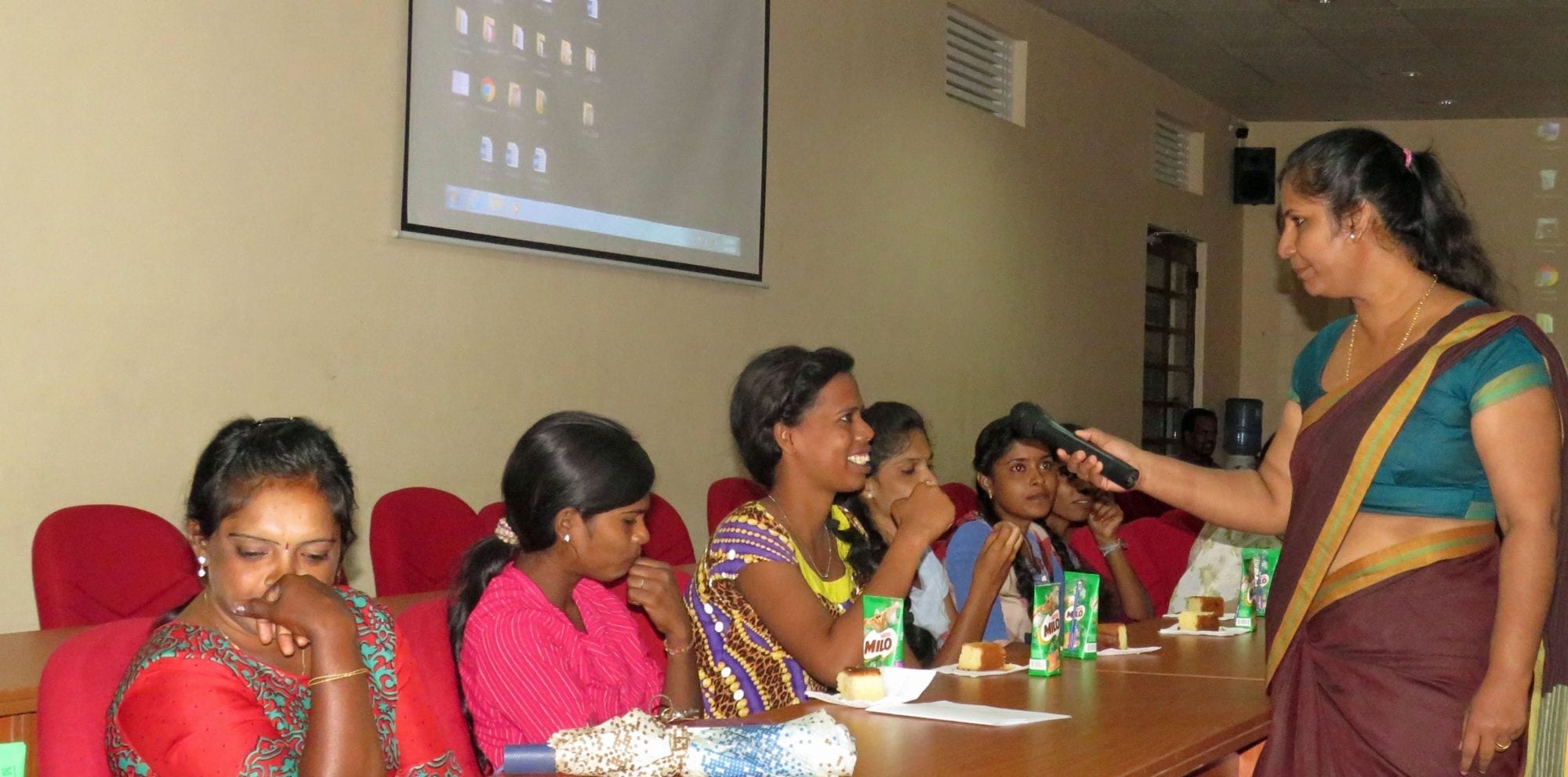
Apr 5, 2018
Nearly 50 cleaning-sector employees from offices throughout Jaffna, Sri Lanka, discussed strategies for addressing gender-based violence at work and how unions can be instrumental in empowering workers to tackle the problem during a recent Solidarity Center training.
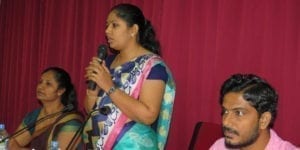
For most participants, the gender equality at work session was their first exposure to the issue. Credit: Solidarity Center/Suthakar
The 28 women and 18 men who provide cleaning services for courts, banks and finance companies began the daylong workshop with a discussion on how workers can be discriminated against based on gender, one aspect of which is gender-based violence at work.
Gender-based violence at work takes multiple forms, including physical and verbal abuse and sexual assault targeted at an individual based on gender. The Solidarity Center is taking part in a global campaign for passage of an International Labor Organization (ILO) convention covering gender-based violence at work.
For most participants, the gender equality workshop was their first experience discussing the issue, and some shared that were not aware of constitutes gender- based violence at work.
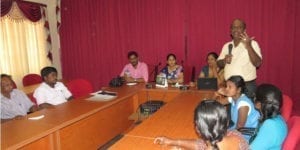
Credit: Solidarity Center/Suthakar
Participants also noted that some of their transgender co-workers frequently are bullied by employers, co-workers and office staff.
Participants also heard from labor lawyers on their fundamental workplace rights, with some saying they did not know they had the right to be paid overtime, double pay on holidays or even that they could form a union. Participants raised many questions about how best to overcome the obstacles they faced in forming unions.
Because “cleaning-sector employees are a very vulnerable working sector, this session aimed to improve their awareness level of basic labor rights and practices,” says Rubini Nishanth, Solidarity Center legal counsel in Jaffna, who moderated the workshop.













